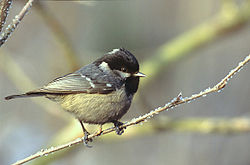Coal tit
| Coal Tit | |
|---|---|

| |
| Scientific classification | |
| Kingdom: | |
| Phylum: | |
| Class: | |
| Order: | |
| Family: | |
| Genus: | |
| Species: | P. ater
|
| Binomial name | |
| Periparus ater | |
| Synonyms | |
|
Parus ater | |
The Coal Tit, Periparus ater (often still Parus ater), is a passerine bird in the tit family Paridae. It is a widespread and common resident breeder throughout Europe, Asia and northern Africa. It is resident, and most birds do not migrate.
The Coal Tit is 10–11.5 cm in length, and has a distinctive large white nape spot on its black head. The head, throat and neck of the adult are glossy blue-black, setting off the white on the nape and sides of the face; the white tips of the coverts show as a double wingbar. The underparts are white shading through buff to rufous on the flanks. The bill is black, the legs lead-coloured and irides dark brown.
The young bird is duller than the adult, the black head having no sheen, and the white of the nape and cheeks is tinged with yellow.
There are a number of subspecies. The British race P. a. britannicus has an olive brown back, distinguishing it from the nominate continental race P. a. ater in which the back is bluish grey. The Irish race "P. a. hibernicus" are most noticed by their strong coloured sulpher-yellow on its cheeks, belly and breast of the bird and is very distinctive. It also features a larger bill than its British and continental cousin. The upper-tail coverts of the Irish bird show a paler rump also. The North African race P. a. ledouci has yellow underparts and cheeks, and the Cypriot P. a. cypriotes has a buff tinge to its upperparts, and deep buff underparts.
Coal Tits will form small flocks in winter with other tits. This species resembles other tits in acrobatic skill and restless activity, though it more frequently pitches on a trunk, and in little hops imitates the Treecreeper. Its food is similar to that of the others; it is keen on beechmast, picks out the seeds from larch and fir cones, and joins Redpolls and Siskins in birches and alders. It will also visit gardens to feed on a variety of foods put out, particularly sunflower seeds. During these food hunts it keeps up an incessant short flight or flock call; the song, if song it can be called, is a strident if-he, if-he, if-he, heard most frequently from January to June, but also in autumn. One variant of this song or call ends with a sharp ichi.
A favourite nesting site is a hole in a rotting tree-stump, often low down, and the nest is deep within the hole; holes in the ground, burrows of mice or rabbits, chinks between the stones in walls, old nests of magpies or other large birds, and squirrel dreys are also occupied. The materials, moss, hair and grass, are closely felted together, and rabbit fur or feathers added for lining; seven to eleven red spotted white eggs of the usual tit type are laid, as a rule, in May, but second broods are rare.
Systematics
This species was first described by Linnaeus in his Systema naturae in 1758 as Parus ater.[1]
Most authorities still treat the Coal Tit in the subgenus Periparus, but the American Ornithologists' Union considers Periparus a distinct genus. This is supported by mtDNA cytochrome b sequence analysis; Periparus seems to be closer to the Poecile chickadees than to other titmice (Gill et al., 2005).
In addition, the same data suggests that this species is paraphyletic in regard to the Spot-winged Tit which looks like a slightly crested, darker version of this bird. Either the Spot-winged Tit could have to be included in P. ater, or some Coal Tits could be considered a distinct species. As with all studies of mtDNA sequences however, hybridization may obfuscate the actual relationships and indeed it appears that it does in this case[citation needed].
References
- ^ Template:La icon Linnaeus, C (1758). Systema naturae per regna tria naturae, secundum classes, ordines, genera, species, cum characteribus, differentiis, synonymis, locis. Tomus I. Editio decima, reformata. Holmiae. (Laurentii Salvii). p. 190.
P. capite nígro, dorso cinereo, occipíte pectoreque albo.
- Template:IUCN2006 Database entry includes justification for why this species is of least concern
- Gill, Frank B.; Slikas, Beth & Sheldon, Frederick H. (2005): Phylogeny of titmice (Paridae): II. Species relationships based on sequences of the mitochondrial cytochrome-b gene. Auk 122: 121-143. DOI: 10.1642/0004-8038(2005)122[0121:POTPIS]2.0.CO;2 HTML abstract
External links
- BBC Radio: Coal Tit song. Retrieved 2006-NOV-21.
- RSPB: Coal Tit. Includes song and video. Retrieved 2008-MAR-13.
- Ageing and sexing (PDF) by Javier Blasco-Zumeta
